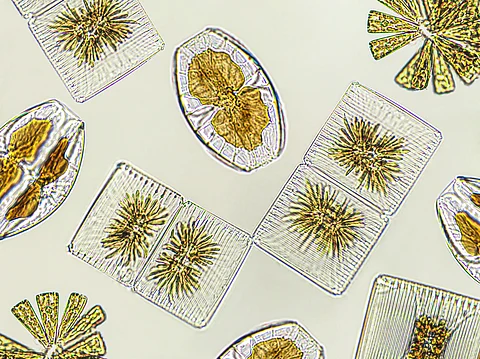

Study reveals that when climate warming reduces phytoplankton levels by just 16-26%, the carrying capacity for fish plummets by 38-55%. Pictured: Diatom phytoplankton under the microscope.
Photo: Adobe Stock.
New research led by Plymouth Marine Laboratory has revealed that the impact of rising ocean temperatures on plankton size and numbers poses a significant threat to global fish stocks.
According to the study, published in Nature Communications, "when climate warming reduces phytoplankton levels by just 16-26% (as projected by global models in regions like the North Atlantic), the carrying capacity for fish plummets by 38-55%."
This constitutes what the researchers call a "hidden amplifying mechanism", where even small declines in plankton can lead to much bigger drops in fish stocks.
Previously, global-scale computer simulations have predicted a decline in phytoplankton in low to mid latitudes. This is due to warming sea temperatures, where the surface layers of the ocean become insulated from the supply of nutrients from below.
The downward trend has already been noted in the North Atlantic, where plankton levels have declined over the past 50 years.
However, the researchers point out, the impact of this process on stocks of commercially-exploited fish has remained unclear.
"Some models suggest little change in fish and others project a major decline and importantly, the mechanisms vary greatly from model to model. These discrepancies show that we are still far from knowing how these food webs work," the research team noted in a PML news release.
Instead, the researchers, including Dr. Angus Atkinson from Plymouth Marine Laboratory and Dr. Axel Rossberg from Queen Mary University of London, used field data instead of computer simulations, looking directly at the size structure of plankton.
"The relative abundance of small and large organisms provides a handy, direct measure of how efficiently the food web transmits energy from the smallest phytoplankton up to fish," the team said.
The researchers compiled a large global database on marine and freshwater plankton size structure.
They found that the overall amount of phytoplankton in the water is the main factor determining the flow of energy through the food web, from microscopic plankton to commercially-sized fish.
The researchers say that warming oceans thus impact fish indirectly, "by reducing nutrient supply from deeper waters, ultimately shrinking phytoplankton size, and hindering energy transfer throughout the food web."
"Close to shore or in lakes, excess nutrients from land can cause imbalances like harmful algal blooms. But at the vast scales relevant to climate change, it's the lack of nutrients from deeper waters that becomes the major bottleneck," said Dr. Axel Rossberg (Queen Mary University of London).
Photo: Adobe Stock.
"Our global analysis sheds light on a hidden vulnerability," Atkinson said.
"We were surprised to find temperature didn't directly affect food web efficiency. Instead, we see ecosystems adapting to warming by changing plankton size. This suggests the main threat comes from reduced nutrient supply, leading to smaller plankton, longer food chains, and inefficient foraging."
While in shallower seas, warming waters can cause an apparent overabundance of plankton - as in the recent spate of harmful algal blooms - the bigger picture shows that warming oceans will actually lead to a lack of nutrients, the researchers explain.
"Close to shore or in lakes, excess nutrients from land can cause imbalances like harmful algal blooms. But at the vast scales relevant to climate change, it's the lack of nutrients from deeper waters that becomes the major bottleneck," said Rossberg.
"Global averages can mask the true picture," added Atkinson. "Some of the most significant projected declines are in areas with concentrated fishing activities."
The study calls for a "multi-pronged approach" to ensure sustainable fisheries in the face of climate change.
"We need a combination of data on plankton size structure and sophisticated computer simulation models to design truly 'climate-smart' ocean protection strategies," Rossberg argues.
"By understanding the hidden amplifiers within the food web, we can better safeguard the future of our oceans and the vital resources they provide."
